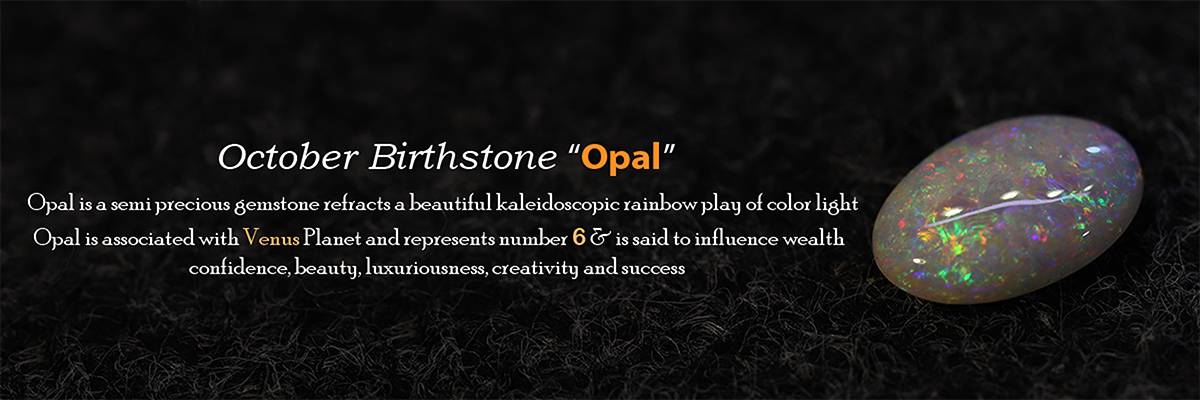
ABOUT OPAL STONE
Opal Information
In the vast and sunburned landscapes of Australia, a geological masterpiece unfolds beneath the surface, giving rise to one of the world’s most enchanting and flaunting gemstones— Opal Stone. The formation of opals in Australia is a captivating tale rooted in the ancient landscapes of the Outback. Over millions of years, silica-rich solutions seeped into fissures and cavities of sedimentary rocks, such as sandstone and clay. Silica-rich rains once flowing through the fissures and cavities of sedimentary rocks, left behind a legacy and vast coverage of opulence. As water evaporated, silica spheres intricately arranged themselves, creating the porous matrix that defines the opal and this sphere matrix arrangement is completely responsive for its unique play-of-color. We will read more about opal stone, its types, history, value factors, lore and everything in detail below.
Australia’s opal fields like Coober Pedy, Lightning Ridge and Mintabie, are producing more than 95% of the worlds opal demand and exhibits most precious opals that dance with rainbow in the gemstone world. Opal lovers for the World and its importance in Astrology make each opal a piece of colorful geological poetry and a symbol of nature’s artistry.
How is Opal Forms ?
Opals are mesmerizing gemstones renowned for their kaleidoscopic play-of-color, which gives them a unique and captivating appearance. The formation of opals is a fascinating geological process that unfolds over millions of years. Here’s an overview of how opals are formed:
Parent Rock Formation:
Opals are often formed in sedimentary rocks, where silica-rich solutions find their way into gaps and cavities. The parent rock is typically a host rock like sandstone, basalt, or rhyolite.
Presence of Silica Gel:
The key component for opal formation is silica. Water carrying dissolved silica infiltrates the rock through cracks or fissures. This can happen during the decomposition of volcanic ash, as silica-rich groundwater percolates through the earth.
Creation of Spherical Structures:
As the silica-rich water seeps into the rock, it forms gelatinous spheres of silica. These spheres settle in layers, creating a structured pattern.
Drying and Hardening:
Over time, the silica spheres lose water and harden, creating a solid but porous structure. The regularity of these spheres influences the play-of-color observed in opals.
Play-of-Color Effect:
The play-of-color, the signature characteristic of opals, is the result of light interacting with the silica spheres. When light enters the opal, it diffracts into the spectral colors we perceive. The size and arrangement of the silica spheres determine the colors and patterns visible.
However, The color you see varies with the sizes of the spheres. In addition, spheres that are approximately 0.1 micron (one ten-millionth of a meter) in diameter produce violet and spheres about 0.2 microns in size produce red. Most importantly, Sizes in between these two, produce the remaining rainbow colors.
Types of Opal stone
Opals come in various types, each with its unique characteristics based on color play, transparency, and overall appearance. The main types of opal gemstones include:
Precious Opal:
Play-of-Color: Precious opals exhibit a distinctive play-of-color, where spectral hues dance and shimmer across the surface as the gem is viewed from different angles. This optical phenomenon is caused by the diffraction of light within the silica spheres.
Common Opal:
Lack of Play-of-Color: Unlike precious opal, common opal does not display the vivid play-of-color. Instead, it often appears in a single, solid color or may have a milky or translucent appearance. Common opals are valued for their soft, subtle beauty.
Vivid Colors: Fire opals are known for their intense hues of orange, red, and yellow. While they may lack the play-of-color seen in precious opals, their vibrant and warm tones make them highly desirable. Australia is a significant source of fire opals.
Black Opal:
Dark Background: Black opals are characterized by a dark body tone, providing a striking contrast to the vibrant play-of-color. Lightning Ridge in Australia is famous for producing some of the finest black opals in the world.
White Opal:
Light Background: White opals have a lighter body tone compared to black opals, and they often showcase a subtle play-of-color. These opals are generally more common and are found in various locations, including Australia.
Crystal Opal:
Transparency: Crystal opals are prized for their transparency, allowing the play-of-color to be visible against a clear or semi-transparent background. These opals can be found in various colors and are highly valued for their clarity.
Boulder Opal:
Matrix Inclusion: Boulder opals form within ironstone concretions, and the opal is naturally attached to the host rock. This type often displays a unique blend of color against the dark ironstone matrix, creating a distinctive appearance.
Matrix Opal:
Embedded in Host Rock: Matrix opals are formed when precious opal is embedded within a host rock, such as ironstone or sandstone. The play-of-color occurs within the opal veins, creating an intriguing mosaic effect.
Properties Of Opal
| Category | Mineraloid |
| Chemical Name | Hydrous silicon dioxide |
| Chemical Formula | SiO2·nH2O |
| Crystal System | Amorphous |
| Colours | Colourless, white, yellow, orange, pink, red, green, blue, brown and black |
| Hardness | 5.5 – 6.5 on the Mohr scale |
| Refractive Index | 1.440 |
| Specific Gravity | 2.23 – 2.95 |
| Transparency | Transparent, translucent and opaque |
| Birefringence | None |
| Lustre | Vitreous |
| Cleavage | None |
| Streak | White |
| Fluorescence | White opal – white, bluish, brownish, greenish; fire opal – greenish to brown |
Interesting Facts & Myths about Opal Stone
0.1 to 0.2 MICRONS
Grids of silica spheres 0.2 microns in size create red play-of-color flashes and 0.1 microns create violet hues.
Upto 20% WATER
Opal contains up to 20% water trapped in its silica structure.
1601
The “William Shakespeare” describe opal as a miracle stone and queen of gems.
How is Opal Valued ?
Color, Brightness, Pattern, Cut, Carat Weight and Origin are important value factors of Opal.
Color
The most crucial factor in determining opal quality is the presence and vibrancy of the play-of-color. A high-quality opal will display a vivid and dynamic range of colors, often including red, orange, yellow, green, blue, and violet.
Cut
A well-cut opal enhances its visual appeal. The shape should complement the play-of-color and maximize the use of the gemstone’s natural characteristics. The more properly cut in shape with defined dimensions are higher in quality.
Carat Weight
Carat size is a very important factor that always distinguishes the opal demand. Larger opals, all other factors being equal, tend to be more valuable. This is because larger, high-quality opals are rarer and require more skill to cut and polish without damaging the stone.
Brightness
Brightness refers to the intensity of the colors in the play-of-color. The brighter and more vivid the colors, the higher the quality of the opal. Opals with a dull or weak play-of-color are considered lower in prices but they have same quality.
Factors affecting Opal Value
Opal FAQs
How many days will it take to see Opal effects ?
Original & genuine Australian Opal stone effects in a few days after wearing it properly with pooja energization with full of feelings and belief. Upon this, the wearer will start experiencing harmony and mutual understanding with the partner. Also, the wearer will be observing success in financial and professional prospects. Their mind will start thinking positively.
Which is better- Opal or Diamond or Zircon ?
Those three gemstones, Opal, Diamond and Zircon are known to wear for strengthening Venus planet but have different astrological benefits and metaphysical properties. Diamond and Zircon are the hard gemstones and may have negative impact on the wearer. But opal stone is soft and there is no negative impact of opal on the wearer until the “Karma” goes good. Also, the price of Opal stone is very reasonable as compared to Diamond and Original Zircon. Opal is also put some effects on other planet also, whereas Diamond or Zircon don’t. Therefore, we can say that, Opal is better than Diamond or Zircon.
Can I wear Opal in my left hand?
Yes, you can wear Opal in your left hand. However, the Opal gemstone finger is the ring finger of the working hand, so if your dominant hand is left, then Opal is worn on the left hand. Consult an expert astrologer before wearing Opal to know which hand suits you the most.
Can I wear Opal and Emerald together ?
Yes, you can wear Opal and Emerald together. They bring positive benefits in the life of the wearer. However, consult an astrologer before wearing these two gemstones together. For more details read our blog https://aakarshanopal.com/blog/best-crystal-combinations-with-opal-stone/ .









